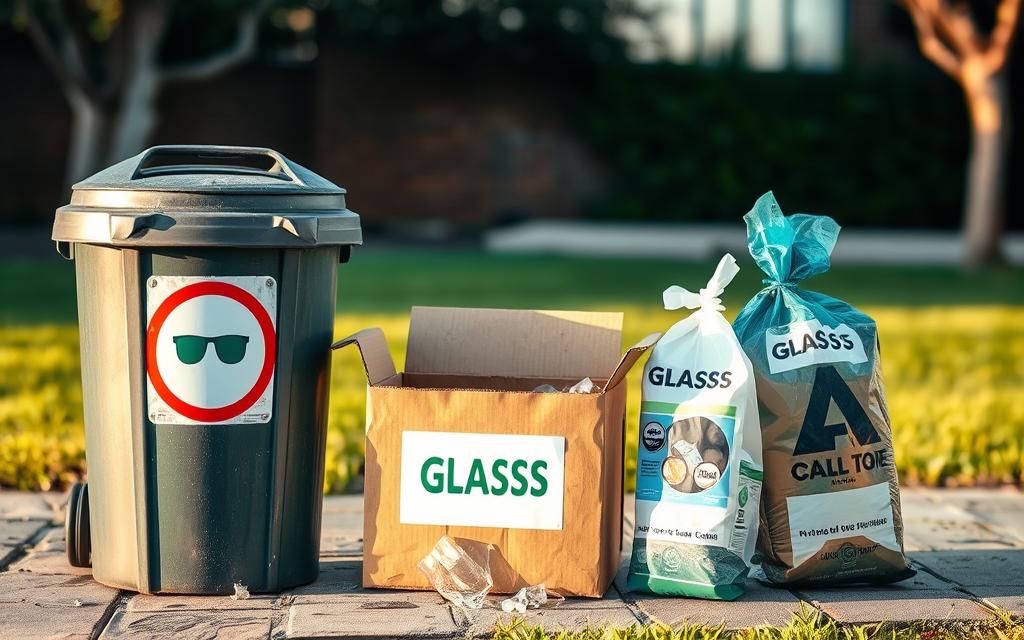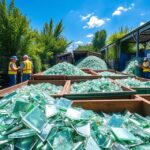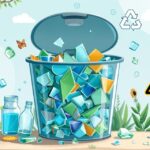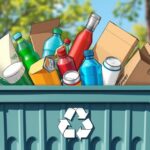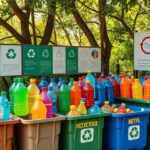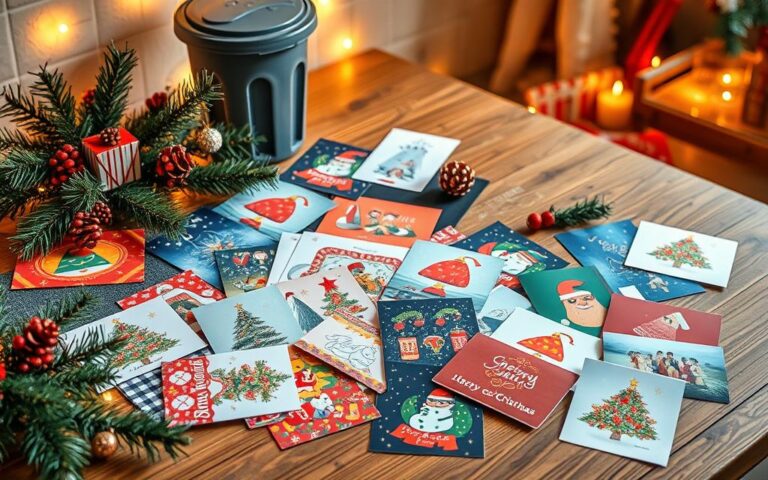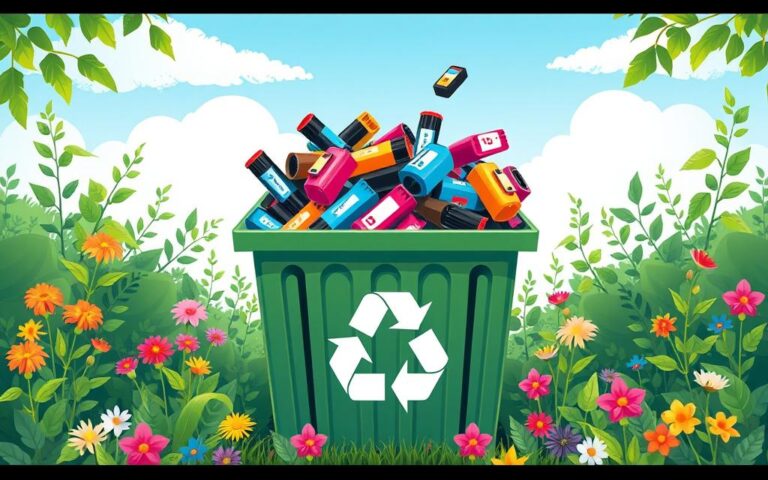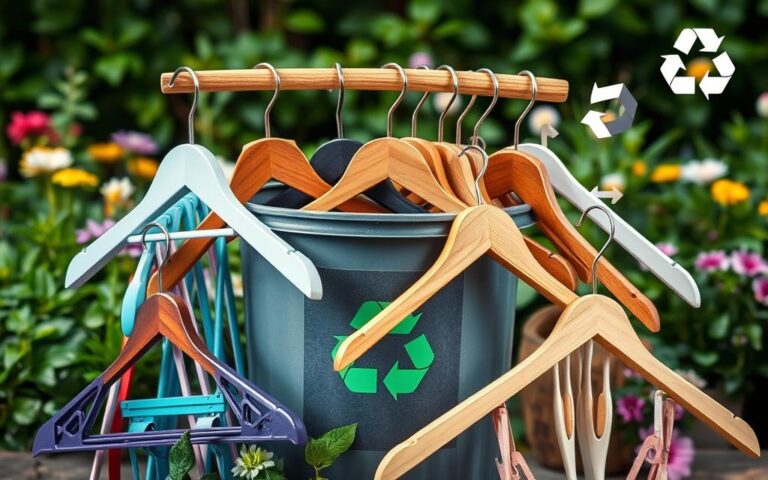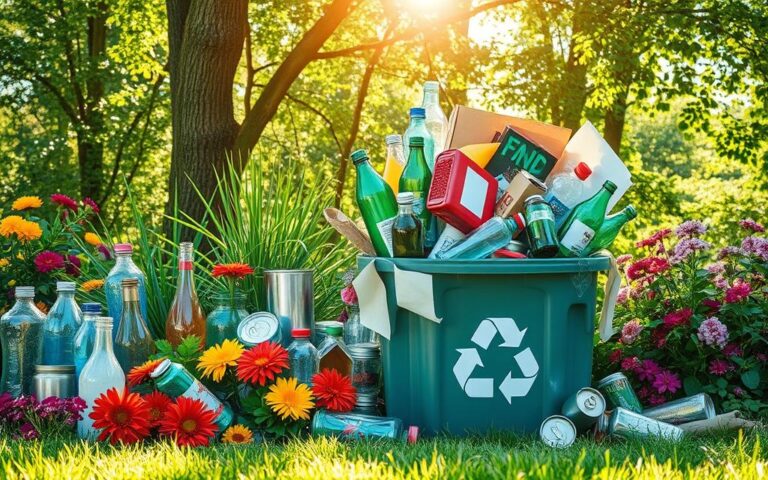Can You Put Broken Glass in the Recycling Bin? How to Dispose of It
Is it okay to put broken glass in the recycling bin? Sadly, it’s not that simple. Most people think recycling broken glass is easy. But, the truth is, it’s quite complex. Only whole bottles and jars should go into recycling. Broken pieces are risky and cause problems.
In 2011, Americans produced about 11.5 million tons of glass waste. But, only 28 percent was recycled. Interestingly, 90 percent of this recycled glass was turned into new jars and bottles. Yet, adding broken glass to the recycle bin can contaminate it and damage the new products made. This shows why it’s vital to follow correct glass disposal rules.
If you want to dispose of glass responsibly, there are safe ways to do it. Understanding these methods is important. It helps ensure we handle broken glass the right way. To dive deeper into glass recycling and how to properly get rid of broken pieces, check out this resource.
Understanding the Basics of Glass Recycling
Glass recycling is crucial in managing waste. It involves different types of glass and how they can be recycled. This reduces the harm to our environment and saves natural resources. Knowing the glass recycling basics lets people make smart choices about how to throw away glass.
Types of Glass and Their Recyclability
There are many types of glass, each with features that affect if they can be recycled. We can often recycle:
- Drinking glasses and bottles
- Food jars and containers
- Clear, green, and brown glass bottles
But, some glass items can’t usually be recycled in your local area. These include:
- Mirrors
- Ceramics
- Window panes
- Automotive glass
- Crystal
- Heat-resistant glass, like Pyrex
Remember, glass can be recycled over and over without losing quality. This makes it a very green choice if thrown away the right way.
The Importance of Proper Disposal
It’s key to throw glass away correctly. Wrong disposal methods can mix unwanted materials with recycling, harming its effectiveness. Due to this, less glass is properly recycled, which isn’t good for recycling efforts. In the United States, out of 10 million metric tons of glass waste every year, only a third is recycled. But in European countries, they recycle about 90% of glass. This shows how crucial correct disposal is for high recycling rates.
Can You Put Broken Glass in the Recycling Bin?
It is vital to know how to dispose of broken glass safely and efficiently. Many people think all glass, even broken, can go into the recycling bin. This is not true. Not every glass type is recyclable, and wrong disposal can pose big risks.
Common Misconceptions About Glass Recycling
Many believe broken glass can be recycled with other items. This idea is incorrect. Broken glass complicates single-stream recycling systems. While the U.S. recycles about 3 million tons of glass yearly, mainly jars and bottles, broken items like windows and mirrors usually end up in landfills. Most recycling centers don’t accept them.
- Not all glass is recyclable.
- Mixing different glass types complicates the recycling process.
- Single-stream facilities often reject glass altogether.
Risks and Hazards of Mixing Broken Glass with Recyclables
Broken glass isn’t just a safety hazard. It can contaminate recyclables, causing more waste and reducing efficiency. Recycling centers find it tough to separate contaminated materials. This can impact the quality of recycled goods. Many places won’t accept glass because of these problems.
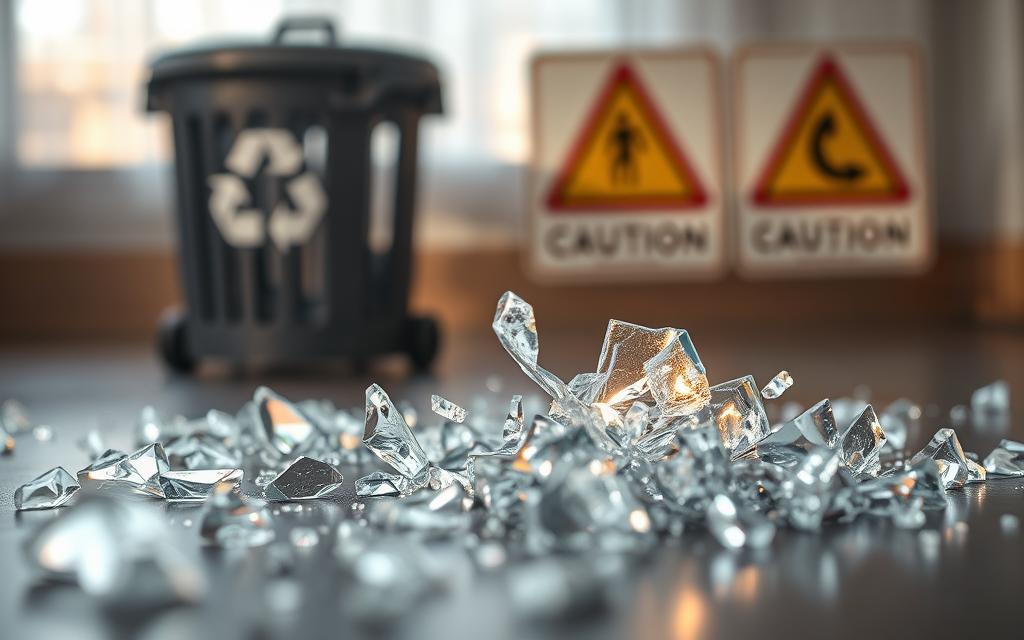
| Type of Glass | Recyclable? | Notes |
|---|---|---|
| Glass Containers (jars, bottles) | Yes | Widely accepted in recycling bins |
| Window Glass | No | Made with chemicals unsuitable for recycling |
| Mirrors | No | Incompatible with container glass recycling |
| Light Bulbs | No | Hazardous materials prevent recycling |
| Pyrex and Cookware | No | Higher melting points complicate recycling |
It is important to understand how to correctly deal with broken glass. Knowing the right disposal methods helps keep our recycling efforts effective and our communities safe.
What Happens to Broken Glass in Recycling Facilities?
Understanding the fate of broken glass in recycling centers uncovers the complexity involved. Many factors make it hard for recycling centers to process broken glass. The need for careful handling impacts how well recycling can be done.
Challenges Faced by Recycling Plants
Recycling centers face many problems with broken glass. Small shards can damage the machinery. This leads to more breakdowns, raising costs and downtime.
Plus, mixed glass types make the sorting process harder. This may lower the quality of recycled items.
- Inadequate equipment to handle mixed glass types
- Frequent breakdowns attributed to glass shards
- Increased safety hazards for workers
- Financial repercussions from reduced product quality
Potential Negative Impact on Other Recyclables
Glass contamination doesn’t just affect glass. It can hurt the recycling of other materials, too. Contaminated items often get thrown out, lowering recycling rates. Only about 40% of glass from single-stream collection ends up recycled. This is compared to about 90% from systems that separate items. This highlights the importance of proper sorting.
| Recycling System Type | Percentage Recycled |
|---|---|
| Single-Stream Collection | 40% |
| Multistream Collection | 90% |
How to Safely Dispose of Broken Glass
Disposing of broken glass safely is important. You need to be careful and plan well. Knowing the best way to clean up and taking precautions makes injuries less likely.
Steps to Clean Up Broken Glass
Dealing with broken glass safely is a must. Here are steps to help you:
- First, look for large glass pieces and pick them up with tongs. This keeps your hands safe.
- For smaller pieces, a damp paper towel works well. It picks up tiny bits you might not see.
- Put all glass in a strong, puncture-proof container. Make sure it is closed well.
- Write “Danger: Broken Glass” on the container. This warns others.
- Close the container with packing tape for extra safety.
- Last, put the box in a safe place, in a trash bag, until you can throw it away right.
Recommended Safety Precautions
Using safety measures is key when cleaning up glass. Here are some precautions:
- Wear gloves that glass can’t cut through to keep your hands safe.
- Wear shoes that cover your whole foot to protect from cuts.
- Don’t vacuum up broken fluorescent bulbs or thermometers. It releases dangerous stuff into the air.
- Use a flashlight to find glass shards that are hard to see.
- Know your local rules for throwing away dangerous waste. Find out if recycling centres near you take broken glass.
Different Types of Broken Glass and Their Disposal Methods
It’s important to know about broken glass and how to dispose of it. Some types, like those at home, need special handling because of what they’re made from. Others can be easily recycled in big systems. Knowing how to dispose of glass keeps our environment healthy.
Household Glass Items: Lightbulbs, Mirrors, and Drinkware
Some home glass items require extra care. Lightbulbs need special disposal to deal with harmful materials, like mercury. Many places offer specific spots to recycle them.
Mirrors and window glass usually can’t be recycled because of their coatings. However, they can often be given away or sold. Organizations like Habitat for Humanity sometimes accept these items, helping with their projects.
- Lightbulbs: Lightbulb recycling is important because of their dangerous materials.
- Mirrors: They can’t be recycled, but you can donate or sell them.
- Drinkware: Most can’t be recycled and should go with regular trash.
Industrial Recycling Options for Specific Glass Types
Many glass types can be reused through industrial recycling. Containers like bottles and jars usually can be recycled if clean. This means washing out any leftovers and taking off anything not made of glass.
It’s key to know which glass items can’t be recycled. Below is a list of what can and can’t be recycled:
| Type of Glass | Recyclable | Disposal Method |
|---|---|---|
| Glass bottles and containers | Yes | Rinse, remove caps & labels, recycle |
| Drinkware | No | Regular waste |
| Mirrors | No | Donation or landfill |
| Lightbulbs | Yes (specific recycling centres) | Drop-off at designated recycling points |
| Window glass | No | Donation or landfill |
Innovative Alternatives for Broken Glass Disposal
Getting rid of broken glass can be tough, but there are smart ways to do it. Creative glass reuse can cut down waste and spark art projects. You can find good options at local bottle banks or recycling centres. This helps everyone get involved in green practices.
Reusing Glass Fragments in Creative Projects
Making art from broken glass is very fulfilling. Here are some ideas:
- Creating mosaic designs using small glass pieces.
- Fragmented glass can be incorporated into garden decor or wind chimes.
- Jewellery makers often use glass shards to craft unique pieces.
This shows how you can avoid throwing away glass, and instead, help the planet. Setting up workshops can teach skills and reduce waste.
Contacting Local Bottle Banks and Industry Recyclers
Before you throw glass away, ask local recyclers about their policies. Many are keen to help the environment and may collect broken glass. Asking them will tell you:
| Facility Type | Services Offered | Contact Method |
|---|---|---|
| Local Bottle Banks | Collection of glass items including broken glass | Phone or Email |
| Recycling Centres | Special arrangements for broken glass disposal | Website Form or In-Person Visit |
| Industry Recyclers | Advanced processing for broken glass | Phone Inquiry |
Using these facilities is good for the planet and helps our community stay green.
Conclusion
Properly disposing of glass is very important. Glass can be recycled many times without losing quality. But, if broken glass gets mixed in, it can cause problems. These problems include risks to those who handle the recycling and possible contamination.
This means we need to be careful about how we get rid of broken glass. To keep our community and our planet safe, following the right steps is key.
It’s important to follow the rules set by your local area on how to recycle glass. This helps us cut down the chance of making recycling harder. Also, using pieces of glass for craft projects is a great way to reuse them. This way, we can be creative while helping the environment.
Being careful and learning the best ways to recycle glass makes a big difference. If we all use the correct methods, we can keep the planet cleaner. We’ll also save resources and need less energy to make new glass items. Let’s work together to make recycling better for everyone in the future.
FAQ
Can broken glass be recycled in the recycling bin?
No, don’t put broken glass in the recycling bin. It’s a safety risk and can mess up other recyclables. Follow the right methods to get rid of it safely and according to local rules.
What are the different types of glass that can be recycled?
You can recycle single-use glass bottles and jars. But, things like mirrors, lightbulbs, and shattered glass can’t be recycled. They have materials and chemicals that are hazardous.
What risks are associated with mixing broken glass with other recyclables?
Mixing broken glass with recyclables poses dangers. It can harm recycling workers and spoil good recyclable materials. Always keep them separate.
What challenges do recycling facilities face with broken glass?
Facilities struggle with tiny glass pieces and different glass types. These can break machinery and raise safety risks. Broken glass also lowers the quality of other recyclable goods.
How can I safely dispose of broken glass?
Wear gloves and put the glass in a labelled box. Clean up carefully. Wear shoes that cover your feet and use the right tools for safety.
What should I do with household glass items like lightbulbs and mirrors?
Items like lightbulbs and mirrors need careful disposal. They have harmful bits. Check local services or recycling schemes for how to dispose of them safely.
Are there creative ways to reuse broken glass?
Yes, you can turn broken glass into art projects. Or, see if local recycling spots or businesses could use it. It’s a way to be responsible and creative.

